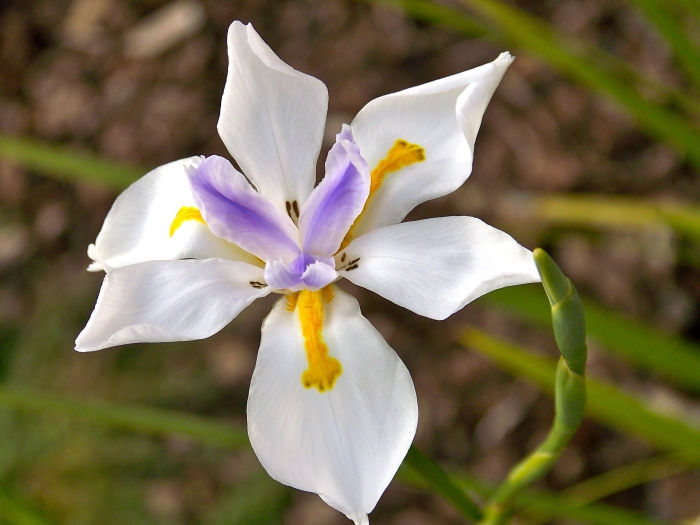Large Wild Iris
(Dietes grandiflora)
Large Wild Iris (Dietes grandiflora)
/
/

Rojer Wisner
CC BY 2.0
Image By:
Rojer Wisner
Recorded By:
Copyright:
CC BY 2.0
Copyright Notice:
Photo by: Rojer Wisner | License Type: CC BY 2.0 | License URL: https://creativecommons.org/licenses/by/2.0 | Uploader: Flickr upload bot | Publisher: Wikimedia Commons | Title: Dietes_grandiflora_or_Fairy_Iris.jpg | Notes: {{ Catchable fatal error: Object of class FlinfoRaw could not be converted to string in /home/www/kunden/ramselehof.de/wikipedia/flinfo/FlinfoOut.php on line 128 |





































Estimated Native Range
Summary
Dietes grandiflora, commonly known as large wild iris, African iris, or fairy iris, is a rhizomatous perennial herb native to the Eastern Cape of South Africa, where it thrives in open grasslands and at forest margins. It features long, rigid, sword-like green leaves and produces showy white flowers marked with yellow and violet. These blooms appear mainly in spring and summer, lasting a couple of days before giving way to 5 cm long green capsules filled with very dark brown seeds that disperse when the capsule splits open.
The large wild iris is valued for its striking flowers and ability to form dense clumps, which can be used effectively for mass plantings in gardens. It is drought and frost hardy, requiring minimal maintenance once established, and can adapt to a range of soil types, though it prefers well-drained soil. It is suitable for use in mixed borders, as an accent plant, or for naturalizing areas. While it performs best in dappled shade to full sun, it will tolerate shaded conditions, albeit with reduced flowering. Regular deadheading can encourage more blooms. Dietes grandiflora can be potentially invasive outside its native range, so gardeners should consult local regulations before planting.CC BY-SA 4.0
The large wild iris is valued for its striking flowers and ability to form dense clumps, which can be used effectively for mass plantings in gardens. It is drought and frost hardy, requiring minimal maintenance once established, and can adapt to a range of soil types, though it prefers well-drained soil. It is suitable for use in mixed borders, as an accent plant, or for naturalizing areas. While it performs best in dappled shade to full sun, it will tolerate shaded conditions, albeit with reduced flowering. Regular deadheading can encourage more blooms. Dietes grandiflora can be potentially invasive outside its native range, so gardeners should consult local regulations before planting.CC BY-SA 4.0
Plant Description
- Plant Type: Herb
- Height: 3-4 feet
- Width: 2-3 feet
- Growth Rate: Rapid
- Flower Color: White
- Flowering Season: Spring, Summer
- Leaf Retention: Evergreen
Growth Requirements
- Sun: Full Sun, Part Shade
- Water: Medium
- Drainage: Medium
Common Uses
Bee Garden, Butterfly Garden, Drought Tolerant, Groundcover, Low Maintenance, Showy Flowers, Street Planting
Natural Habitat
Open grasslands and forest margins of the Eastern Cape of South Africa
Other Names
Common Names: Wild Iris, African Iris, Large Wild Iris
Scientific Names: , Dietes grandiflora,
GBIF Accepted Name: Dietes grandiflora N.E.Br.